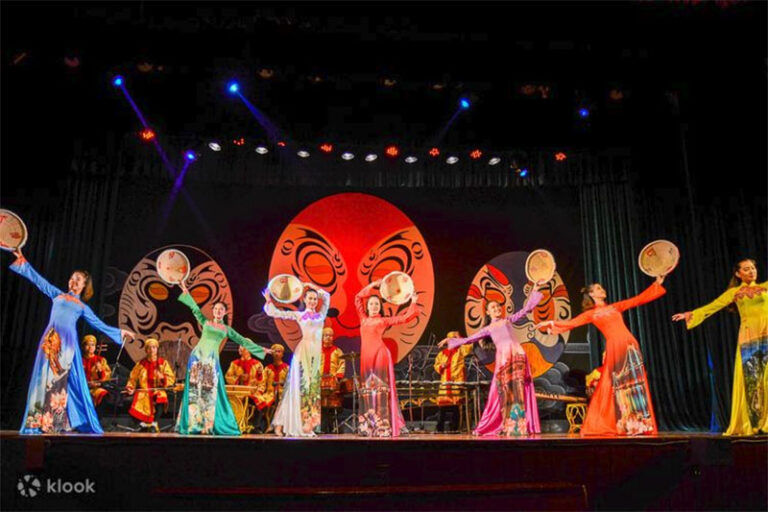
Vietnamese Traditional dance, also known as folk dance, was created by Vietnamese people and passed down through many generations, reflecting the good values of each ethnic group in the community of 54 ethnic groups in Vietnam.
Vietnamese traditional dance originated from people’s daily lives in many localities, so it reflects a diverse living and cultural space, highlighted by closeness and community cohesion, a place for everyone to enjoy and unite with each other, regardless of age or class.
Viewers can recognize their predecessors’ creativity and aesthetic sensibility through folk dances. At the same time, we can see contemporary customs and social relationships. The expression of people’s religious and moral life can be seen primarily through the dances that appear in the rituals of worshiping Buddha, Tan Vien saint, Mother Goddess, or the custom of honoring Hung King.
Contents
- 1 History of formation and development of Vietnamese traditional dance
- 2 The meaning of Vietnamese traditional dance art
- 3 Some types of Vietnamese traditional dance
- 4 Work to preserve and develop Vietnamese traditional dance
History of formation and development of Vietnamese traditional dance
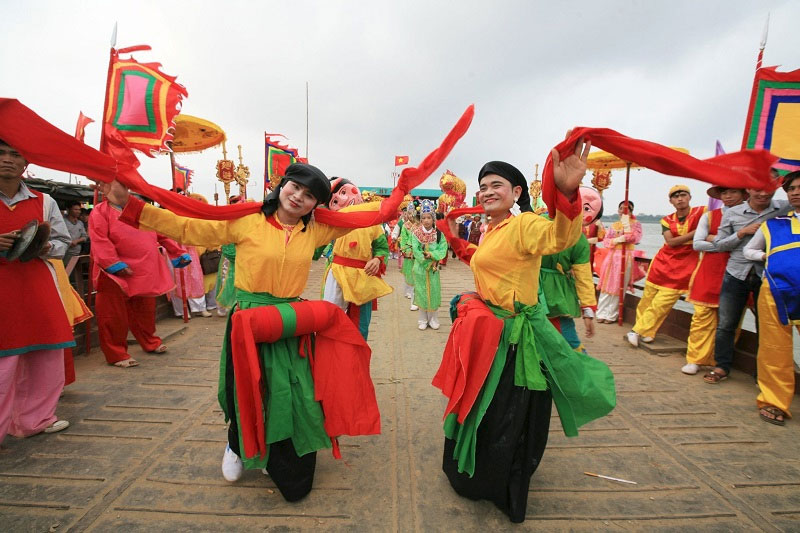
Since its inception, Vietnamese traditional dance has carried the mark of wet rice civilization and agriculture. It is closely associated with nature and animals, with dances depicting scenes of production, hunting, and community activities. The images of everyday life that go into dance are stylized or artisticized by the artist’s talent. Therefore, dance art is an essential element in Vietnamese culture. Community life is clearly expressed through dance because it is not the performance of one person but the activity of a group of people using art to serve the masses.
It is difficult to determine the birth date of traditional Vietnamese dance art. In general, research shows that the art of dance was born from the treasury of folk performances (including serving people’s beliefs and enjoyment needs). If, before the 10th century, dance was often used in religion, then since the state’s independence, dance art has developed more widely among the people and was enhanced artistically by the feudal court. Village farmers can only enjoy the art of dance at village festivals or temple ceremonies. Still, it is deeply ingrained in their subconscious, and they influence and develop folk dance.
Folk and royal dance developed under different conditions and had their approaches. That mainly depends on the organizers, actors, and audience reception. Mentioning folk dance can show the development of this form and its role in history. Folk dance is a type of art performed publicly by non-professional actors. They are usually farmers when village festivals or festivals need them to participate in practice and performances.
The feudal court showed concern and had transparent institutions for the people to implement. In 1025, Ly Thai To appointed the warden position for those who danced and sang to serve in villages and communes when opening festivals at spring ceremonies. During this period, dance guilds were organized by the people themselves. The Tran Dynasty developed folk dance and singing to increase people’s spirit and harmony, contributing to national unity. But in the post-Le period, folk dancing and singing were limited, especially the dancing and singing of ethnic minorities, which were looked down upon.
By the Nguyen Dynasty, folk dance and royal court were separated. Royal dance focuses on ceremonial functions or symbols of kingship, while folk dance is reserved for customs and rituals.
The meaning of Vietnamese traditional dance art
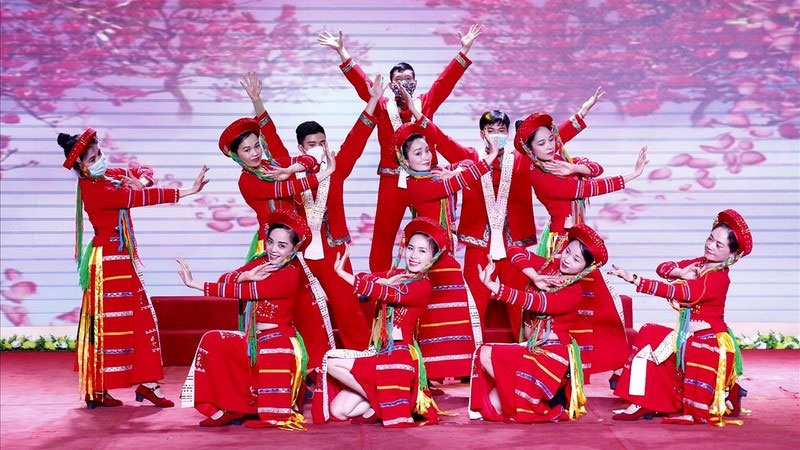
Through folk dances, viewers can recognize their predecessors’ creativity and artistic sensibility, expressing their thoughts, feelings, and real life through dances, thereby revealing the customs and traditions of their ancestors and contemporary social relationships from the moral and religious aspects.
The language of folk dance mainly reflects the movements that reflect the labor process of villagers: farming, fishing, hunting, etc. But it takes work to express whatever you want. Vietnamese people dance with drums, lights, fans, and especially empty-handed dance movements with outstanding characteristics of softness, flexibility, lyricism, and grace.
The artist brings harmony and symmetry of beauty into the dance movements. The movements represent the character’s gender: the female dancer is soft, flexible, and leisurely. She mainly dances with her arms, with round, curvy lines, and no broken corners; her body does not move vigorously, and her legs are often closed and use pillows. Men’s dancing is generous with open and robust movements of arms and legs, but inside, there is hardness and softness. At the same time, the character’s emotions and personality are also expressed in dance movements.
The wavy lines expressed through many dance movements, dance lines, and dance formations highlight the nuances of wet rice culture and the Vietnamese people’s charm, sophistication, and discreetness. Umbrella dances, Khen dances of the Mong people, shield dances, and spear dances of the Central Highlands ethnic groups, in terms of movement rules, shapes, and dance lines, have many rich and different points. Therefore, the choreographer must accurately grasp the language, formation, dance structure, and environmental, social, customs, and cultural elements in each dance work’s customs, “soul” and “identity” of each nation.
The community’s development of folk dance has led to diverse melodies and performances. Folk artists come from villages and are attached to rural life, so they understand and act closer to the lives of village people. Each region has unique dances; sometimes, that uniqueness is spread to many communities in other areas. The art of dance cannot achieve the movement from one cultural space to another, but its value has brought it to many different regions. When classifying folk dances, the widespread appearance of rowing dances in all parts of the country is worth noting, entering communities’ cultural and spiritual activities in many different areas.
Spiritual and Social Meaning
Traditional dance is not only a symbol of beauty but also carries with it many spiritual and social meanings. From the gentle drizzle of the lion dance during the Hung Temple festival to the precise movements of the quan ho dance, each performance is a way to show respect and solidarity within the community.
Some types of Vietnamese traditional dance
1. Water Puppet Show – Unique and Famous Dance Art
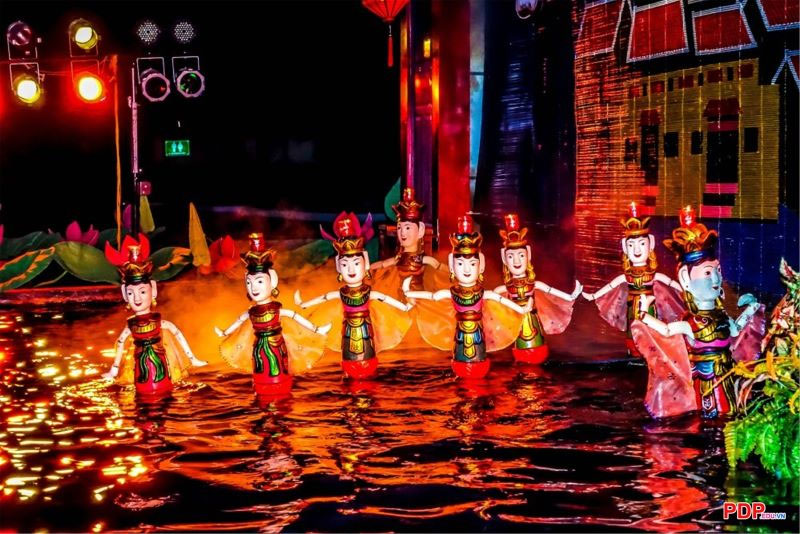
Puppet dancing, one of Vietnam’s most unique performing arts forms, is expressed through sophisticated puppets and traditional music. Puppeteers are not only puppeteers but also multi-talented artists, conveying profound cultural values.
Water puppetry originated in the Red River Delta, where there is a lot of rain and farmers’ lives depend on the rainy season. Performed since the 10th century, water puppetry is not only entertainment for the community but also a way to educate and tell stories to children.
Water puppetry is often performed on water, with puppeteers standing up to their necks in water, creating the image of puppets floating on the water. Puppet control requires talent and technique, with a team of artists having to master while dancing and telling stories.
Water puppet shows often tell stories about history, legends, and daily life. The characters in puppetry are often diverse, from simple farmers to legendary gods and heroes. Each performance brings a vibrant and engaging story.
2. Lion dance
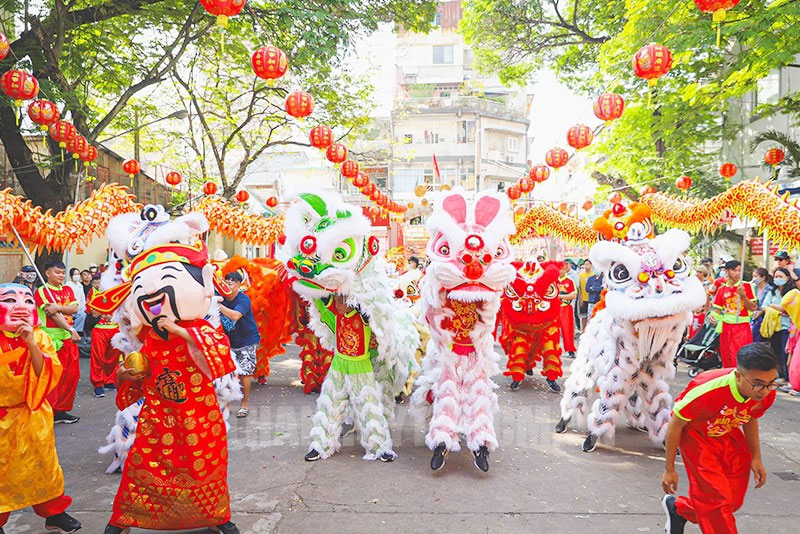
Lion dance, a form of traditional cultural performance, is indispensable to important festivals and events in Vietnam. This type of art brings excitement and joy and symbolizes luck, wealth, and health in Vietnamese folk culture.
Lion troupes often represent lion dance with red, yellow, green, and white fur. Artists often need dexterity and attention to control the unicorn’s movements to light and fast-paced music. Besides, flexible, gentle, and highly artistic dance movements are outstanding features of lion dance.
3. Fan dance
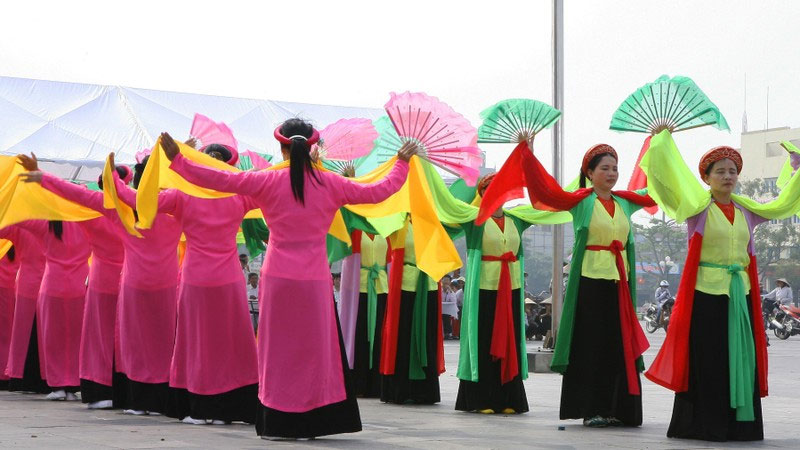
Fan dance originates from folk traditions but has been developed and refined in traditional court and lantern arts. The history of fan dancing is closely linked to feudal dynasties, where it became a high-class art form, serving festivals and momentous occasions.
Fan dancing often uses lightly colored and decorative fans, which the artist moves delicately and gracefully to light and comfortable music. Fan dance movements often focus on the flexibility of the hands and arms, creating harmonious and beautiful images.
4. Court Dance
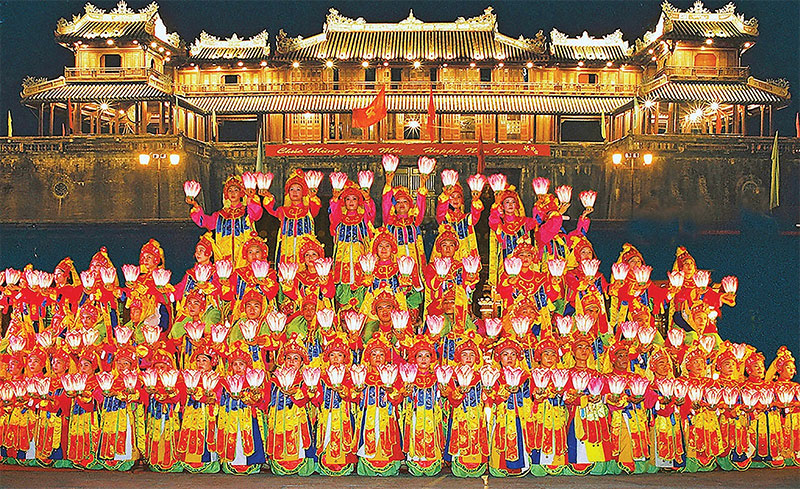
The court dance is an enduring symbol of Vietnamese performing arts, reflecting ancient court life’s elegance, sophistication, and royalty. This art form is part of preserving and developing historical culture and a symbol of nobility and class.
The Court dance originated from the long-standing royal courts in Vietnam, especially the Le and Nguyen dynasties. Developed and perfected over centuries, royal dance has become a unique cultural symbol, expressing sophistication and dignity in royal rituals.
Royal dance often uses soft, gentle, and delicate movements combined with traditional music and splendid costumes. Court dancers often perform during festivals, offerings, and receptions of distinguished guests, creating a solemn and elegant atmosphere.
5. Quan Ho Dance – The Beauty of Love and Cultural Interference
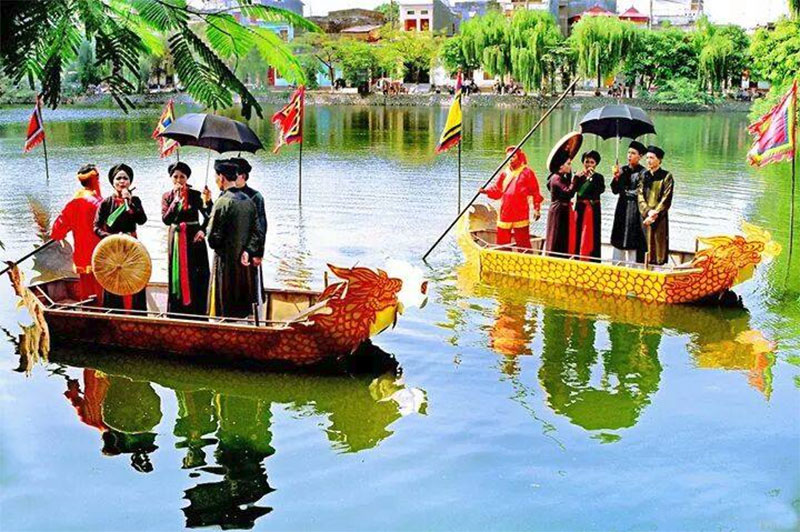
Quan Ho dance, a unique traditional Vietnamese dance form, often occurs during wedding ceremonies. The beauty of Quan Ho dance is not only in the soft dance steps but also in the way it contributes to creating a unique cultural picture, combining intimacy and cultural interference.
Quan Ho dancing is often accompanied by Quan Ho singing, creating a unique musical and performance picture. Artists often move gently and gracefully, showing the interaction between men and women. Essential characteristics are hand gestures and precise steps, demonstrating respect and polite feelings.
Quan Ho dance often occurs in traditional spaces such as villages, communal houses, or classic stages. Artists usually wear traditional costumes, highlighting the beauty and ornamentation of folk culture.
Quan ho is an entertainment art and a way of social exchange and expressing polite feelings between men and women. Each song often contains cultural messages, love of homeland, and gratitude to ancestors.
6. Ethnic Dance and Cultural Richness
Ethnic minorities in Vietnam also contribute to the picture of traditional dance with unique performances. Xoe dance of the Tay people, tribute dance of the Ta Oi people, or water dance of the Thai people – each performance is a combination of tradition and unique creativity of each community.
6.1. Tay Nung Lion Dance
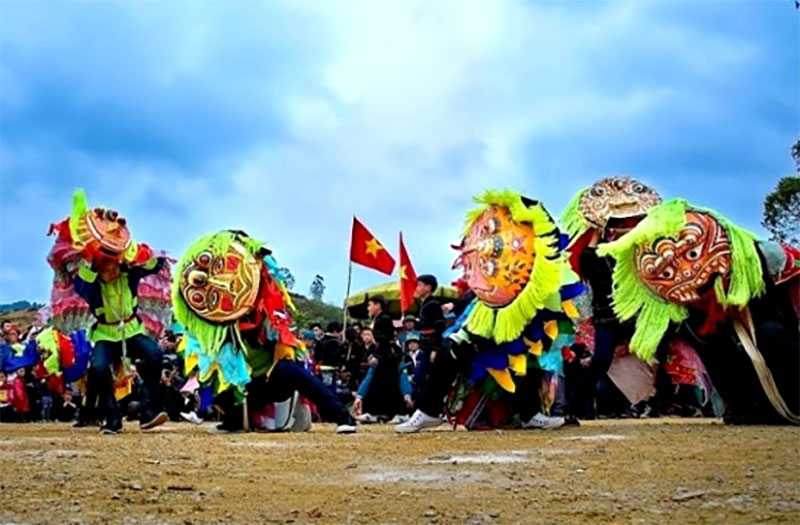
The Lion dance is a folk dance of the Tay and Nung ethnic groups, often performed during spring, Mid-Autumn, or field festivals. According to legend, the lion is the king of the forest – the King of animals. The Tay and Nung people believe that the appearance of lions at the beginning of the year is a good omen, a sign of peace in the world, so lion dancing will ward off evil spirits, kill all epidemics that kill livestock, and help make farming and business easier easy, prosperous, and happy life. Therefore, the lion dance festival is meticulously prepared and enthusiastically participated by the Tay and Nung people.
6.2. Chhay-dam Drum Dance
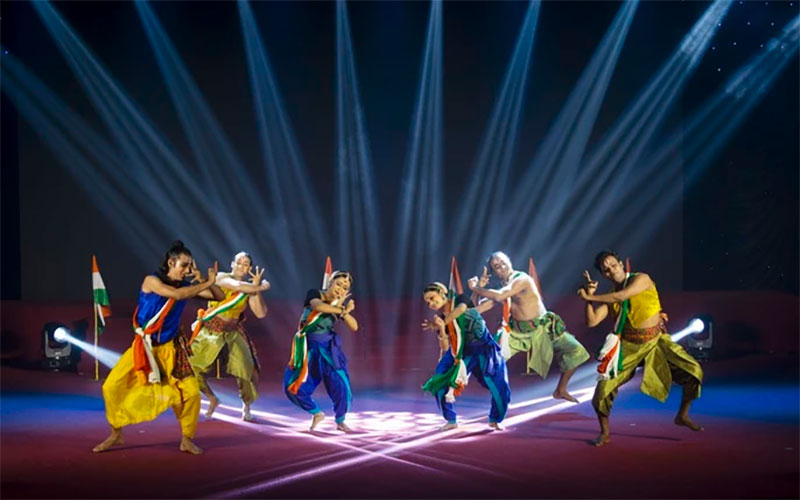
Chhay-dam drum dance is a unique folk dance of the Khmer people, often performed during festivals such as Chol Chnam Thmay Tet, Dolta festival, Ooc – om – boc,… Chhay-dam drum dance was formed during labor, passed down among the people, and developed into an attractive and fun performing art form.
6.3. Dong Anh Light Dance
There are many different names and definitions for Dong Anh Light Dance. To unify the name for Dong Anh Light Dance after consulting with musician Le Van Hoe, Thanh Hoa chemist Phan Bao, and musician Nguyen Lien in the book Dong Anh Lamp Dance Music: Lamp Dance – Dong Anh: Is a singing and dancing performance of the villagers of Vien Khe Dong Anh with a lamp plate made of peanut oil on their head, lit with 10 – 12 wicks.
6.4. Bai Bong Dance
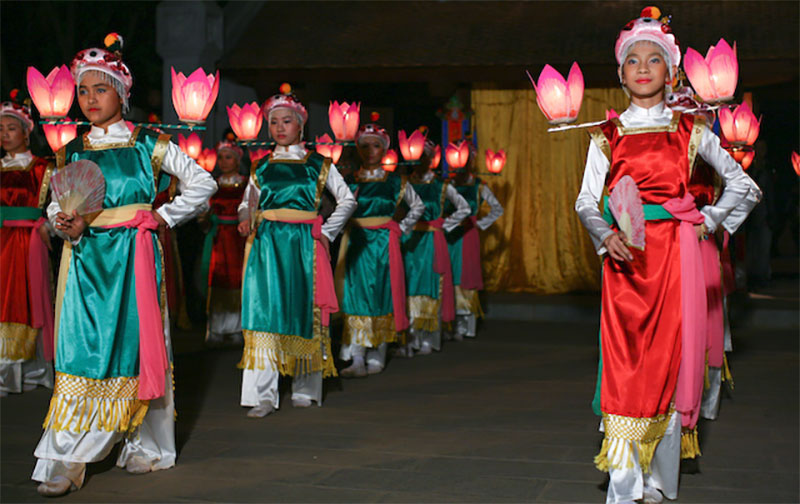
Bai Bong dance, also known as catching cotton cards, is a dance in the system of dances of the Ca tru art (including bat bo dance, four spirit dance, and cotton card dance).
According to researchers, cotton card dancing appeared during the Tran dynasty. According to the book “Vietnam Ca Tru Bien Khoa“, this dance was created by Tran Quang Khai to sing and dance during the Thai Binh festival King Tran Nhan Tong organized after defeating the Yuan-Mongol invaders for the third time. Although the origin and creator of the Bai Bong dance has yet to be agreed upon, it can be confirmed through historical sources that the Bai Bong dance is a unique form of folk song and folk dance of the Dai country—Vietnamese under the Tran Dynasty are over 700 years old.
Bai cotton dance consists of 9 acts, but most only perform six bare acts: the first act, the song Spring (praising the joyful scenery of heaven and earth and people’s hearts in Spring), then the songs Summer, Autumn, Winter.
Work to preserve and develop Vietnamese traditional dance
As an essential part of the cultural heritage, Vietnamese traditional dance faces challenges from the modern era and rapid social change. Conservation has become a crucial trend to maintain and develop this performing art.
To preserve and develop traditional dance, art organizations, and schools increasingly focus on training the younger generation. Not only dance technique but a deep understanding of culture and history helps traditional dance stay aware of the challenges of the new era.
The participation of the local community is an essential key to preserving traditional dance. Organizing events, festivals, and classic dance competitions helps create opportunities for people to experience dance and increases pride and conservation awareness.
To adapt to the modern era, artists and art organizations must find ways to combine traditional and contemporary elements in dance performances. This increases the fun and helps traditional dance retain its appeal to young audiences.
The government and arts organizations must focus on funding and policy support for preserving traditional dance. These resources can be used to organize events, build arts centers, and provide funding for conventional artists.